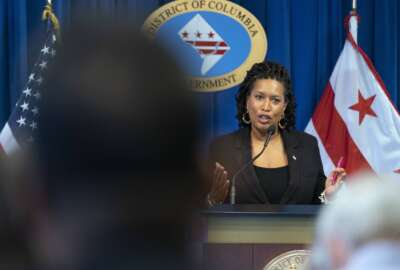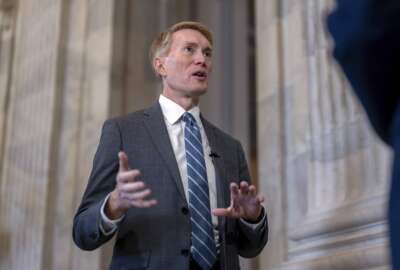Agency CIOs coveted new Digital, Shared Services strategies
Federal CIO Steven VanRoekel said the new documents met three of five action items that agency technology managers developed last winter. OMB received buy-in not...
wfedstaff | April 17, 2015 3:47 pm
The Office of Management and Budget now has released two major strategies in the past month, giving agency chief information officers a host of new deadlines.
But a funny thing happened on the way to developing the goals: the CIOs asked for them.
So as agency technology managers redo their 12-month plans to incorporate the Digital Management Strategy released Wednesday, or the Shared Services Strategy released in early May, don’t feel too bad for them as they are trying to fix agency shortcomings.
“This [digital] strategy and many of the other complimentary strategies were founded out of some work we did last winter with the CIO community,” said Steven VanRoekel, federal CIO, in an exclusive interview with Federal News Radio. “We had a two-day offsite at a federal facility here in [Washington] where at the beginning of the two days, I said at the end of the two days we need to have a set of action items we will take out of these meetings that we are going to run and execute on them together. Out of the top five, three of them are represented in the digital strategy, the Shared Services Strategy and the open data stuff we are doing. So we have the weight of the federal CIO community behind us and rallying toward this.” 
VanRoekel and federal Chief Technology Officer Todd Park detailed the Digital Management Strategy and the new Presidential Innovation Fellows program during a event sponsored by ACT/IAC and AFFIRM.
“They are all identifying the move to mobile, the consumerization of technology and everything as the imperative that they need to seize upon,” VanRoekel said. “This [digital] strategy takes a very comprehensive approach across multiple communities. To be successful, you can’t just focus on either a great dialogue in the plan or the end product. You have to focus on the execution.”
That means, OMB didn’t just stay within the CIO community, but reached across the chief financial officers, the chief acquisition officers and chief human capital officers communities to obtain their buy-in before finalizing the strategy.
A license to innovate
Beyond agency executives, VanRoekel said the digital/mobile plan gives middle-to-upper managers a license to be innovative.
“The bottom line in these series of announcements isn’t just bringing people in from the outside or coming up with a new strategy, [but] it’s us giving them permission to unleash the potential that exists through their experience of consumer technology on the model that is government,” VanRoekel said. “It’s taking that next step to really unleash all of this power of technology in the way we work, the way we interface with Americans and the way we really meet the mission of government.”
He said these mid-level employees are using the consumer-driven technology by shopping online or using smartphones for everyday needs, and now bring the same expectation to government as other citizens do that the services and systems work in a mobile and digital environment.
The strategy begins to address some of those expectations. VanRoekel said OMB will lead an effort to develop a governmentwide bring-your-own-device (BYOD) policy.
Through the Digital Strategy Innovation Center, which will be run by the General Services Administration, agencies will have an application development platform, a mobile device management platform and a consistent way to apply analytics to websites and online resources.
“Part of this is getting these communities together not only to work together collaboratively across the different audiences, but focus on a cross-governmental approach to the things we are doing,” he said. “We tend to have centers of excellence in small places around the government. We’ll have some agency doing great work analyzing security around devices. We’ll have one agency doing a great job with bring-your-own-device. We’ll have one agency focusing on an application delivery model for mobile. The goal here is to have a strategy, have a set of permissions, to work across government to get the government to be more consistent. Let’s take those best practices and scale them laterally versus just in the agencies in which they exist.”
FedRAMP for mobile on the horizon?
One of those communities will be around security and privacy of mobile devices. The strategy calls for the departments of Defense and Homeland Security to work with the National Institute of Standards and Technology to create a mobile security baseline.
VanRoekel said OMB wants a consistent way to authorize devices and applications meet federal cyber standards.
Some in industry termed it a “FedRAMP for mobile.”
“I think the work we are doing in this plan could lead to a FedRAMP for mobile type model,” VanRoekel said. “From an efficiency standpoint, we believe in that model and we definitely want to drive to that.”
Another community is around acquisition. VanRoekel said OMB is developing new guidance for modular or agile development. He said the document is in final clearance so he couldn’t offer too many specifics yet.
RELATED STORIES:
OMB unveils ambitious digital, mobile strategy
OMB gives agencies four months to figure out shared services
Agencies feel strain of balancing mobility, security
Copyright © 2025 Federal News Network. All rights reserved. This website is not intended for users located within the European Economic Area.
Jason Miller is executive editor of Federal News Network and directs news coverage on the people, policy and programs of the federal government.
Follow @jmillerWFED






